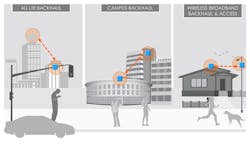This file type includes high-resolution graphics and schematics when applicable.
The growing demand for wireless connectivity in the consumer-electronics and industrial landscapes in recent years has consumed the capacity of existing wireless frequency bands. With the current 2.4- and 5-GHz bands so overcrowded, the 60-GHz band could enable a new wave of devices that utilize integrated multi-gigabit transceivers.
I talked with Lattice Semiconductor’s Neil Bullock about the company’s technology and its SiBEAM Technology Group.
Wong: What are the challenges facing wireless communications?
Bullock: We live in an increasingly wireless world. This is perhaps easiest to observe in terms of consumer electronics, where mobile phones and laptops have helped push the rapid adoption of various wireless standards during the past decade. There were estimated to be 3.4 billion smartphone subscriptions in 2015, with each subscription driving more data demand and pushing mobile-phone networks and their use of licensed spectrum to the limit, and encouraging data offload to unlicensed bands.
The number of Wi-Fi hotspots has grown to more than 175 million worldwide, and is expected to reach 330 million by 2018. The overall number of Bluetooth-incorporated products has also grown, with a 400% increase in Bluetooth-enabled audio devices expected between 2014 and 2018. Because many of these wireless technologies use the same 2.4- and 5-GHz bands, these two frequencies are overburdened and have come under strain.
Wong: Why is Lattice investing in the potential of the millimeter-wave part of the spectrum (30 to 300 GHz)?
Bullock: Lattice, through its SiBEAM Technology Group, was among the first companies to see great potential in the 60-GHz band. This frequency band is license-free in many regions, making it easily adaptable for a variety of applications. It allows for the creation of a new breed of devices with integrated multi-gigabit transceivers, delivering dramatically more bandwidth more consistently than those currently using the overcrowded 2.4- and 5-GHz bands.
Wong: What is unique about the 60-GHz band?
Bullock: Regulators, including the Federal Communications Commission in the United States, have designated a wide band of spectrum for license-free use by commercial industries. The 60-GHz band contains more than 7 GHz of bandwidth –20 times more channel bandwidth than its 5-GHz counterpart. The 60-GHz band offers wide channels that are sufficient to provide multiple gigabits of capacity, and has a number of key propagation and attenuation characteristics that are beneficial for high-performance wireless solutions.
To gain the most benefit from the 60-GHz band, phased-array antennas, highly directional beams, and beamsteering should be used. Lattice Semiconductor builds industry-leading RF transceivers using its SiBEAM technology in production, which implement these techniques using standard complimentary metal-oxide-semiconductor integrated-circuit (CMOS IC) manufacturing and packaging technologies.
Wong: How will 60 GHz aid the adoption of new and developing wireless technologies?
Bullock: Many applications are expected to benefit from 60-GHz technology. For data transfer, 60 GHz is already being utilized as a Wi-Fi replacement, transmitting data at up to 4.6 Gb/s, which is five times faster than the existing 802.11ac standards. The WirelessHD standard enables video streaming between consumer electronics. Manufacturers have already begun to implement WirelessHD in laptops, smartphones, DTVs, video projectors, and virtual-reality headsets, and it’s expected that WirelessHD will expand to mobile, home-theater, and other computing devices.
Additional use cases are starting to develop as well, including wireless backhaul for LTE and Wi-Fi service operators; last-mile fixed access and on commercial, medical and educational campuses to quickly and easily connect buildings; and wireless connectors that allow slimmer and more robust devices.
Wong: What are the most promising applications for the 60-GHz band?
Bullock: The nature of millimeter-wave technology requires that the baseband modem, RF transceiver, and antennas are optimized for a specific range in order to reach the target, which opens up different types of applications. To easily explain the different applications, they can be categorized based on three ranges: 10 millimeters; from one to 10 meters; and more than 100 meters.
Over very short distances (typically around 10 mm), 60-GHz technology can transmit data at very high speeds, creating an effective alternative to wires. It’s also useful as a physical connector replacement technology, particularly for applications that require device durability. It can eliminate the physical connector, which is one of the most common failure points for electronic devices and a common point of entry for water, dirt, and other particles that damage electronics.
In the middle range (1-10 meters), 60 GHz can be a high-speed alternative to existing wireless solutions such as Wi-Fi. Its high bandwidth, low latency, point-to-point architecture, and in-room transmission characteristics also make it an effective cable replacement within a room (i.e., for streaming high-definition video in the home-theater setting).
But the need for more wireless bandwidth and high-speed HD video isn’t limited to the consumer-electronics space.
Wong: What are the other potential applications for wireless 60 GHz beyond consumer electronics?
Bullock: As 60-GHz solutions continue to grow in the consumer-electronics market, manufacturers in the industrial space are finding uses for this technology, too. In many industrial applications, the benefits are the same as in the CE space, with millimeter wave allowing manufacturers to remove cables and increase mobility and flexibility. New use cases that are yielding interest in the industrial space include object detection or gesture recognition, machine vision in factory settings, surveillance, and medical applications.
Overall, the highly desirable features of 60-GHz technology, including low latency, high bandwidth, and minimal interference, make it well-suited for a number of industrial applications representing a significant opportunity for growth.







